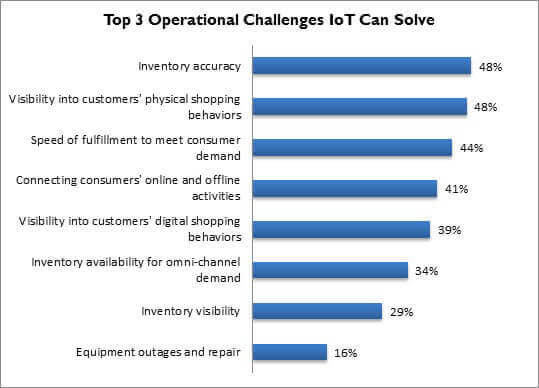Is IoT Worth The Struggle?
In our first-ever Internet of Things research, retailers tell us they will have to face significant internal challenges before they’ll be able to leverage any of the opportunities they perceive from the IoT. I wrote about that long list of challenges in an article a few weeks back. What’s perhaps more interesting, however, is that this is a case where the poison may also serve as cure. Our retail respondents tell us that it’s definitely worth figuring out the unique internal challenges that IoT functionality poses. Why? Because as much of a challenge as these new systems pose today, in the long run, IoT holds tremendous opportunity to help with the operational challenges retailers already have within their current systems.
Figure: The Poison As Cure?

Source: RSR Research, August 2015
When viewed by performance or size, some interesting differences emerge (not pictured):
- Retail Winners are banking on IoT’s ability to help them sort out their inventory accuracy issues (54%, vs others’ 44%). This is vital because retailers consistently tell us throughout our annual research reports – regardless of the topic – that having a precise picture of their inventory is the linchpin to help cure so much of what ails them today. Will IoT systems help get them there faster? It goes without saying that if they do, the rewards will be tremendous. As channels continue to proliferate and consumers continue to lose empathy for a how retailer fulfills their needs, the retailer who can rely on an accurate inventory will be able to fulfill those demands in countless innovative ways. And that will lead to legitimate brand loyalty.
- In a similar vein, Winners are also more optimistic for what the speed of fulfillment to meet consumer demand will do for that brand loyalty. Fifty percent of Winners (vs. 40% of all others) cite this as an operational challenge that stands to benefit from IoT advances. It’s not a huge difference, but again it shows us how Winners keep a consistently sharper eye on what matters most. Their success is not an accident.
- In yet another classic example of performance variance, when faced with a new technology set, average and lagging retailers are more likely to look outwardly at their customers, rather than at their own internal processes: nearly half cite the chance to get a better look at customers’ digital shopping behaviors, while only a little more than 30% of Winners rank this as a hurdle IoT will help them get over. Winners continue to think within the mindset of: “What can we be doing better? ” It’s part of what defines them.
- And lastly, the largest retailers (5B+) are most interested in speed of fulfillment to meet customer demand (57% vs. smallest retailers’ 38%). This makes perfect sense; mega retailers view IoT as a possibility to regain the nimbleness they once had when their enterprises were smaller and far less complex. For small retailers, the message is clear: use every advantage you currently have to meet consumer demand while you can. And hopefully, when that service model enables you to grow, the tools will exist to help you maintain that agility.
We find this to be absolutely fascinating data, and if you’d like to read more, the full report is available here.
